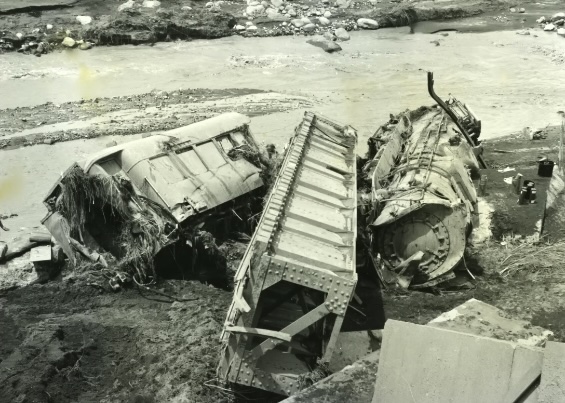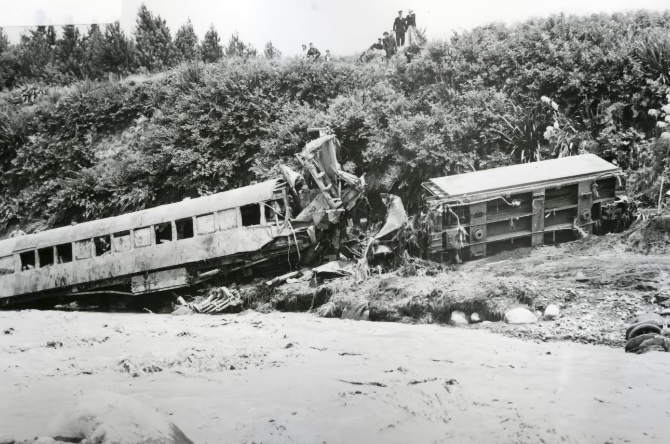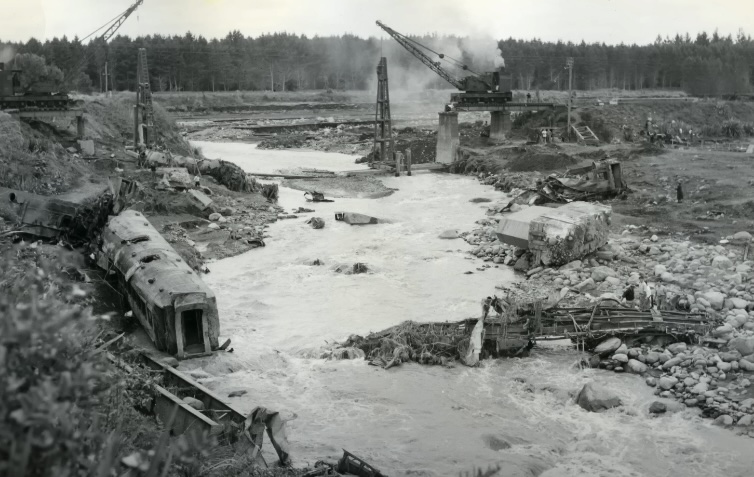The Tangiwai disaster remains one of the most poignant and tragic events in New Zealand’s history. On Christmas Eve of 1953, a catastrophic event unfolded near Tangiwai, North Island, claiming 151 lives. This article delves into the various facets of the disaster, exploring its causes, impact, and the enduring legacy it left on the nation.
Where Did the Tangiwai Disaster Happen?
The Tangiwai disaster struck at the Whangaehu River bridge, located near the small settlement of Tangiwai in the central North Island of New Zealand. The location was largely unremarkable until the night of the disaster, when it became the site of New Zealand’s worst rail tragedy. The bridge, crucial for the North Island Main Trunk Railway, was the point where the tragedy unfolded after a lahar from the nearby Mount Ruapehu crater lake weakened its structure.
The Prelude: Mount Ruapehu’s Eruption
Mount Ruapehu, known for its picturesque beauty and ski slopes, also harbors a darker side. Its activity is a key element in understanding the Tangiwai disaster:
Date of Eruption
On December 24, 1953, Mount Ruapehu unleashed its fury in the form of a devastating eruption, sending shockwaves through the surrounding region and leaving a trail of destruction in its wake. The eruption, occurring on Christmas Eve, added a somber tone to the holiday season for those affected by its aftermath.
Nature of Eruption
The eruption of Mount Ruapehu in 1953 was characterized by the release of a lahar, a type of volcanic mudflow that poses significant hazards to nearby communities and infrastructure. Lahars are triggered by the sudden melting of snow and ice on the volcano’s summit during an eruption, mixing with volcanic debris and forming a fast-moving slurry that cascades down the mountain slopes with immense force.
Impact on the River
The lahar unleashed by Mount Ruapehu’s eruption on December 24, 1953, surged into the Whangaehu River, transforming its tranquil waters into a raging torrent of destruction. The powerful flow of mud, rocks, and volcanic material carried by the lahar wreaked havoc along the riverbanks, causing widespread devastation to the surrounding landscape and infrastructure.
To better visualize the impact of Mount Ruapehu’s eruption and subsequent lahar on the Whangaehu River, consider the following table:
| Aspect of Impact | Description |
| Physical Destruction | The lahar caused extensive damage to buildings, roads, bridges, and other structures along the riverbanks. |
| Environmental Impact | The influx of volcanic material into the river altered its ecosystem and water quality, posing long-term challenges for wildlife and aquatic life. |
| Economic Consequences | The destruction of infrastructure and loss of property had significant economic repercussions for the affected communities, requiring extensive rebuilding efforts. |
| Human Toll | Tragically, the eruption and resulting lahar claimed lives and caused injuries among those caught in its path, leaving a profound human impact on the affected region. |
The Disaster Unfolds

The evening was meant for festive celebrations, but for the passengers of the Wellington to Auckland express train, it turned into a fight for survival. Here’s how the disaster unfolded:
The Disaster Unfolds
The evening of December 24, 1953, was poised for festive celebrations as passengers boarded the Wellington to Auckland express train. However, what awaited them was far from jubilation. Instead, it became a harrowing fight for survival as the train encountered a catastrophic event. Let’s delve into the sequence of events that led to this tragic disaster.
| Time of the Incident | Approximately 10:21 PM on December 24, 1953 |
Train Details
The train, a crucial lifeline connecting Wellington and Auckland, was a vital mode of transportation for many travelers. On that fateful night, it was packed with approximately 285 passengers, each with their own destination and purpose for the journey. As the train hurtled through the night, little did they know that their voyage would soon turn into a nightmare.
| Passenger Count | Around 285 passengers were on board. |
| Route | Wellington to Auckland express train. |
Bridge Collapse
As the train approached a bridge along its route, disaster struck. The bridge, a critical link in the railway network, had been weakened by various factors, including natural wear and tear and environmental conditions. However, what ultimately led to its demise was the force of nature itself – a lahar.
- Cause of Collapse: The bridge collapsed due to the force of a lahar.
- Environmental Factors: Heavy rainfall and volcanic activity contributed to the instability of the bridge.
- Bridge Condition: The structure was weakened prior to the collapse.
Immediate Aftermath
The collapse of the bridge sent shockwaves through the train and its passengers. The sudden jolt, followed by the deafening sound of twisting metal and crumbling concrete, instilled panic and chaos among those on board. As the train plunged into the void left by the collapsed bridge, passengers were thrown about violently, their screams mingling with the roar of the rushing lahar below.
- Panic and Chaos: Passengers were thrown into a state of panic following the collapse.
- Physical Impact: Violent movements caused injuries among passengers.
- Sound of Destruction: Deafening noises accompanied the collapse of the bridge.
Rescue and Recovery Efforts
In the aftermath of the disaster, rescue teams mobilized swiftly to aid the survivors and recover the victims. Emergency services, volunteers, and railway personnel worked tirelessly through the night, braving treacherous conditions to reach the scene of the tragedy. Amidst the wreckage and devastation, they searched for signs of life, using every available resource to extract survivors from the twisted metal and debris.
- Mobilization of Rescue Teams: Emergency services and volunteers quickly responded to the disaster.
- Braving Treacherous Conditions: Rescuers worked in challenging environments to reach survivors.
- Search and Rescue Operations: Efforts focused on finding and extracting survivors from the wreckage.
Lessons Learned
The Wellington to Auckland express train disaster of 1953 stands as a stark reminder of the unpredictable forces of nature and the importance of infrastructure resilience. It serves as a poignant lesson in disaster preparedness, prompting authorities to reevaluate safety measures and reinforce critical infrastructure to withstand future threats. Moreover, it underscores the resilience and courage of individuals in the face of adversity, as communities came together to support one another in the aftermath of tragedy.
- Importance of Infrastructure Resilience: The disaster highlighted the need for resilient infrastructure to withstand natural disasters.
- Disaster Preparedness: Authorities were prompted to review and enhance disaster preparedness measures.
- Community Resilience: Communities demonstrated resilience and unity in the face of adversity.
Immediate Response and Rescue Efforts
The response to the Tangiwai disaster was immediate and frantic, involving several parties:
Local Heroes
In the wake of the Tangiwai disaster, the immediate response from local residents and surviving passengers played a crucial role in the initial rescue efforts.
- Nearby Residents: The close proximity of residents to the disaster site enabled them to respond rapidly. They provided immediate assistance, including helping survivors out of the wreckage and administering first aid.
- Surviving Passengers: Despite facing their own injuries and shock, surviving passengers stepped up to assist others. Their actions ranged from comforting fellow survivors to aiding in the evacuation process, showcasing remarkable courage and solidarity in the face of adversity.
Government Response
The New Zealand government’s response to the Tangiwai disaster was marked by swift deployment of emergency services and coordinated efforts to manage the crisis effectively.
- Emergency Services Deployment: Upon receiving notification of the disaster, emergency services were quickly mobilized and dispatched to the scene. Police, firefighters, and medical personnel worked tirelessly to assess the situation, provide medical aid to survivors, and facilitate the rescue operations.
- Government Coordination: Recognizing the severity of the situation, the government took immediate action to coordinate the response efforts. This involved liaising with various agencies, mobilizing resources, and ensuring clear communication channels to streamline the rescue and recovery operations.
Impact on Families
The Tangiwai disaster left a deep and lasting impact on families across New Zealand, particularly during the holiday season, exacerbating the sense of loss and grief.
- Emotional Toll: Families of the victims were plunged into profound grief and shock upon receiving news of their loved ones’ involvement in the disaster. The sudden and tragic nature of the event compounded their anguish, leaving lasting emotional scars.
- Community Support: In the face of tragedy, communities rallied together to support affected families. They offered practical assistance, emotional support, and organized memorial services to honor the memory of the victims. This outpouring of solidarity helped alleviate some of the burden borne by grieving families, fostering a sense of unity and compassion amidst adversity.
Long-Term Impact and Safety Measures

The Tangiwai disaster had a profound impact on railway safety standards in New Zealand:
Investigation Results
Following the Tangiwai disaster, comprehensive investigations were conducted to determine the root causes and contributing factors. These investigations yielded crucial insights into the deficiencies in existing safety measures, particularly concerning the vulnerability of railway bridges to natural hazards.
| Title | Enhanced Warning Systems |
| Key Finding | Investigations revealed a critical necessity for improved warning systems at railway bridges situated in hazard-prone zones, including volcanic eruption or flood-prone areas. |
| Importance | Insufficient warning mechanisms were identified as a contributing factor to the tragedy, underscoring the significance of early detection and prompt alerts for risk mitigation. |
Changes in Policy
Armed with the findings from the investigations, policymakers swiftly enacted changes to bolster railway safety standards and enhance monitoring protocols for geological hazards.
- Volcanic Activity Monitoring: In response to the heightened risk posed by volcanic activity in New Zealand, particularly in regions traversed by railway infrastructure, authorities implemented enhanced monitoring systems. These systems aimed to provide early detection of volcanic unrest, allowing for proactive measures to safeguard railway operations and passenger safety.
- Infrastructure Assessment: Additionally, there was a concerted effort to conduct thorough assessments of railway infrastructure located near geological hazard zones. This proactive approach enabled authorities to identify vulnerabilities and implement targeted mitigation measures to reinforce the resilience of critical infrastructure against natural threats.
Memorial and Education
The legacy of the Tangiwai disaster is commemorated through a memorial site at the scene of the tragedy, serving as a poignant reminder of the human cost of inadequate safety measures and the importance of learning from past mistakes.
- Memorial Site: The Tangiwai memorial stands as a solemn tribute to the victims of the disaster, providing a place for reflection and remembrance. The site serves as a focal point for communities to come together and pay their respects to those who lost their lives on that fateful day.
- Educational Initiatives: In addition to its role as a memorial, the Tangiwai site serves as an educational resource, offering insights into the events leading up to the disaster and the subsequent safety improvements. Educational programs and guided tours are conducted to raise awareness about railway safety and the importance of proactive risk management strategies.
Remembering Tangiwai: Memorials and Media
The Tangiwai disaster has been commemorated through various means, ensuring that the memories of those lost are preserved:
Tangiwai Memorial
The Tangiwai Memorial stands as a poignant tribute to the victims of the disaster, offering a physical space for remembrance and reflection. Situated near the site of the tragedy, the memorial serves as a focal point for those wishing to pay their respects and honor the lives lost.
- Names of the Victims: The memorial features a plaque or monument inscribed with the names of the individuals who perished in the Tangiwai disaster, ensuring that their identities are forever remembered and honored.
- Reflective Spaces: Surrounding the memorial, landscaped areas or gardens provide visitors with peaceful environments where they can contemplate the significance of the events that occurred and the impact they had on the community.
- Community Gatherings: The Tangiwai Memorial often serves as a venue for community gatherings and commemorative events, bringing together survivors, families, and members of the public to collectively mourn and remember those who were lost.
Documentaries and Films
The story of the Tangiwai disaster has been immortalized through various documentaries and films, each offering a unique perspective on the events and the people involved. These visual representations serve as powerful educational tools, ensuring that the memory of the disaster endures.
- Comprehensive Overviews: Documentaries provide viewers with comprehensive overviews of the Tangiwai disaster, combining interviews with survivors, archival footage, and expert analysis to reconstruct the events leading up to and following the tragedy.
- Personal Stories: Through interviews and firsthand accounts, documentaries and films offer insight into the personal stories of those affected by the disaster, allowing audiences to connect on a human level with the individuals whose lives were forever changed.
- Emotional Impact: By presenting the emotional and human aspects of the Tangiwai disaster, documentaries and films evoke empathy and understanding, fostering a deeper appreciation for the significance of the event and its enduring impact on the community.
Educational Outreach
In addition to memorials and media, educational outreach plays a crucial role in ensuring that the memory of the Tangiwai disaster remains alive in the collective consciousness. Schools, museums, and other institutions actively engage in educational initiatives to teach future generations about this tragic chapter in New Zealand’s history.
- Curriculum Integration: Tangiwai is often included in school curricula, providing students with opportunities to learn about the disaster and its historical context through various subjects such as history, geography, and social studies.
- Museum Exhibits: Museums may feature exhibits dedicated to the Tangiwai disaster, showcasing artifacts, photographs, and interactive displays that offer visitors a deeper understanding of the events and their significance.
- Community Programs: Community organizations may host educational programs and events aimed at raising awareness about the Tangiwai disaster and its impact on the local community, fostering dialogue and remembrance among residents.
Conclusion
The Tangiwai disaster remains a stark reminder of the power of natural forces and the importance of preparedness in the face of potential disasters. Its legacy continues to influence safety protocols and reminds us of the fragility of human endeavors against the might of nature. Through remembering Tangiwai, New Zealand honors both the lost lives and the lessons learned in the wake of this tragic event.
FAQ
The disaster was caused by a lahar from Mount Ruapehu, which compromised the structural integrity of the Whangaehu River bridge.
A total of 151 passengers lost their lives in the disaster, making it the worst rail disaster in New Zealand’s history.
While there have been other rail incidents, none have matched the scale and tragedy of the Tangiwai disaster.
Significant improvements were made in monitoring geological hazards and railway infrastructure, along with better emergency response strategies.
Yes, the memorial is accessible to the public and provides a poignant reminder of the tragic event.
